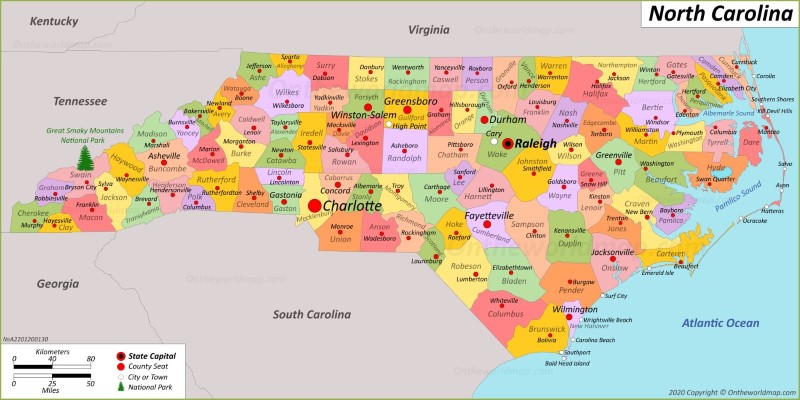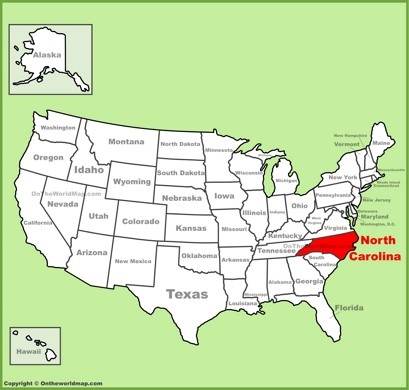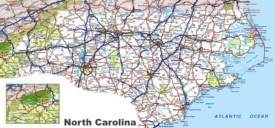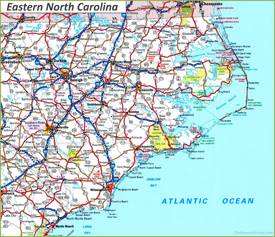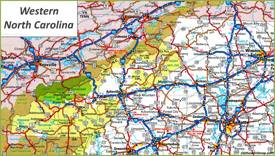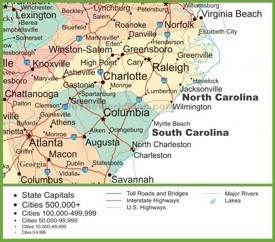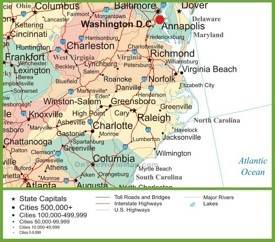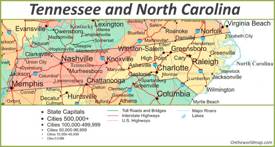North Carolina Map
Description:
This map shows states boundaries, the state capital, counties, county seats, cities, towns, islands and national parks in North Carolina.
Size: 1350x675px / 230 Kb
Author: Ontheworldmap.com
You may download, print or use the above map for educational, personal and non-commercial purposes. Attribution is required. For any website, blog, scientific research or e-book, you must place a hyperlink (to this page) with an attribution next to the image used.
Page Navigation
North Carolina Location Map
Online Map of North Carolina
Detailed Maps of North Carolina
Maps of North Carolina Regions
Maps of North Carolina and Neighbouring States
Other Maps of North Carolina
Google Map of North CarolinaOpenStreetMap
Bing Maps
USGS National Map
North Carolina National Map (National Atlas of the United States)
State Transportation Map www.ncdot.gov 2023-2024 (pdf)
About North Carolina
North Carolina, located in the southeastern region of the United States, bordered by Virginia to the north, Tennessee to the west, Georgia to the southwest, South Carolina to the south, and the Atlantic Ocean to the east.
The capital city, Raleigh, along with Charlotte and Greensboro, serves as primary urban centers for economic and cultural activities. Raleigh anchors the Research Triangle Park, a prominent hub for technology and research. Charlotte stands as the largest city and a significant financial center, hosting operations of major banking institutions. Greensboro, part of the Piedmont Triad, plays a pivotal role in manufacturing and education.
Tourism in North Carolina thrives on diverse attractions. The Great Smoky Mountains National Park, featuring biodiverse ecosystems and scenic vistas, attracts millions of visitors annually. The Outer Banks, a string of barrier islands, offers historic sites such as the Wright Brothers National Memorial, coupled with recreational beaches. Asheville, located in the Blue Ridge Mountains, garners attention for its vibrant arts scene and proximity to the Biltmore Estate, the largest privately-owned house in the United States. Additional notable sites include the Blue Ridge Parkway, a scenic highway renowned for its breathtaking landscapes, and the North Carolina Museum of Natural Sciences in Raleigh.
The Facts:

Flag of North Carolina |

Seal of North Carolina |
| Capital: | Raleigh |
| Largest city: | Charlotte |
| Area: | 53,819 sq mi (139,390 sq km) |
| Dimensions: |
|
| Latitude: | 33°50′ N to 36°35′ N |
| Longitude: | 75°28′ W to 84°19′ W |
| Population (2023): | 10,835,491 [1] |
| Density: | 214.72/sq mi (82.90/sq km) |
| Elevation: | |
| Official language: |
|
| Spoken language:[3] |
|
| Religion: |
|
| Racial/ethnic groups (2022):[4] |
|
| Median household income: | $52,752[5] |
| USPS abbreviation: | NC |
| ISO 3166 code: | US-NC |
| Time zone: | UTC−05:00 (Eastern) Summer (DST) UTC−04:00 (EDT) |
| Official website: | www.nc.gov |
List of The Largest Cities in North Carolina by population
| Rank | City | County | Population (2022)[6] |
|---|---|---|---|
| 1 | Charlotte | Mecklenburg | 897,720 |
| 2 | Raleigh | Wake, Durham | 476,587 |
| 3 | Greensboro | Guilford | 301,115 |
| 4 | Durham | Durham, Wake, Orange | 291,928 |
| 5 | Winston–Salem | Forsyth | 251,350 |
| 6 | Fayetteville | Cumberland | 208,873 |
| 7 | Cary | Wake, Chatham | 180,388 |
| 8 | Wilmington | New Hanover | 120,324 |
| 9 | High Point | Guilford, Randolph, Davidson, Forsyth | 115,067 |
| 10 | Concord | Cabarrus | 109,896 |
| 11 | Asheville | Buncombe | 93,776 |
| 12 | Greenville | Pitt | 89,233 |
| 13 | Gastonia | Gaston | 82,653 |
| 14 | Apex | Wake | 71,065 |
| 15 | Jacksonville | Onslow | 70,420 |
| 16 | Huntersville | Mecklenburg | 63,035 |
| 17 | Chapel Hill | Orange, Durham | 62,098 |
| 18 | Burlington | Alamance | 59,287 |
| 19 | Kannapolis | Cabarrus, Rowan | 55,448 |
| 20 | Rocky Mount | Edgecombe, Nash | 54,013 |
| 21 | Mooresville | Iredell | 52,656 |
| 22 | Wake Forest | Wake, Franklin | 51,113 |
| 23 | Wilson† | Wilson | 47,606 |
| 24 | Holly Springs | Wake | 45,945 |
| 25 | Hickory | Catawba, Burke, Caldwell | 44,084 |
List of Cities in North Carolina Alphabetically
North Carolina Beach Towns
Main sights in North Carolina
- Blue Ridge Parkway
- Outer Banks
- Cape Hatteras
- Biltmore Estate
- North Carolina Museum of Natural Sciences
- North Carolina Aquarium
- North Carolina Zoo
- Chimney Rock State Park
- Grandfather Mountain
- Wright Brothers National Memorial
- Dry Falls
- Battleship North Carolina
Counties of North Carolina
The state of North Carolina, consists of 100 counties.
List of counties in North CarolinaNorth Carolina County Map

Regions of North Carolina:
- Western North Carolina
- Central North Carolina (Piedmont)
- Eastern North Carolina (Coastal Plain)
National Parks in North Carolina
Great Smoky MountainsGeography of North Carolina
North Carolina covers an area of approximately 53,820 square miles and is rich in diverse landscapes. The state divides into three primary regions: the Coastal Plain, the Piedmont, and the Mountains.
The Coastal Plain, located in the eastern part of the state, features flat, low-lying terrain and extensive wetlands. This region includes the Outer Banks, a series of barrier islands known for their sandy beaches and historical significance.
Moving westward, the Piedmont region presents a rolling landscape with elevations ranging from 300 to 1,500 feet. This area serves as the industrial and urban heart of the state, hosting major cities such as Charlotte, Raleigh, and Greensboro. It also includes fertile agricultural lands and numerous rivers.
The westernmost region, the Mountains, forms part of the Appalachian Mountain range, including the Blue Ridge and Great Smoky Mountains. This area offers rugged terrain with peaks exceeding 6,000 feet, such as Mount Mitchell, the highest point in eastern North America. The mountainous region is noted for its biodiversity and scenic beauty, attracting numerous outdoor enthusiasts.
Islands of North Carolina
Major Rivers in North Carolina
- Roanoke River
- Neuse River
- French Broad River
- Cape Fear River
- Tar River
- Yadkin River
- Dan River
- Catawba River
- New River
- Little Tennessee River
- Great Pee Dee River
- Haw River
- Deep River
- Waccamaw River
- North Toe River
Lakes of North Carolina
- Lake Norman
- Jordan Lake
- Fontana Lake
- Falls Lake
- Phelps Lake
- Lake Jocassee
- Lake Waccamaw
- Lake Wylie
- Lake Mattamuskeet
- Chatuge Lake
- Kerr Lake
- Badin Lake
Mountain Ranges
- Appalachian Mountains
- Blue Ridge Mountains
- Unaka Range
- Great Smoky Mountains
- Black Mountains
- Plott Balsams
The 15 highest mountain peaks of North Carolina
Reference [7]- Mount Mitche (6,684 ft / 2037 m)
- Mount Craig (6,647 ft / 2026 m)
- Clingmans Dome (6,643 ft / 2025 m)
- Mount Guyot (6,621 ft / 2018 m)
- Balsam Cone (6,600 ft / 2012 m)
- Mount Gibbes (6,520 ft / 1987 m)
- Mount Chapman (6,417 ft / 1956 m)
- Richland Balsam (6,410 ft / 1954 m)
- Old Black (6,370 ft / 1942 m)
- Celo Knob (6,327 ft / 1928 m)
- Blackstock Knob (6,320 ft / 1926 m)
- Waterrock Knob (6,292 ft / 1918 m)
- Roan High Knob (6,285 ft / 1916 m)
- Mount Lyn Lowry (6,240 ft / 1902 m)
- Luftee Knob (6,234 ft / 1900 m)
Brief History of North Carolina
North Carolina's history traces back to its early Native American inhabitants, including the Cherokee and Tuscarora tribes. European exploration began in the 16th century, with the English establishing the Roanoke Colony in 1587, famously known as the "Lost Colony" due to its mysterious disappearance.
In 1710, North Carolina split from South Carolina, becoming a separate British colony. It played a crucial role in the American Revolution, with significant battles such as the Battle of Guilford Courthouse in 1781. North Carolina became as the 12th state in 1789, later seceded during the Civil War, joining the Confederacy.
Post-war Reconstruction brought economic upheaval, but the state eventually industrialized, focusing on tobacco, textiles, and furniture. In the 20th century, North Carolina evolved into a hub for research and technology, especially with the development of Research Triangle Park in the 1950s. Today, the state's rich historical tapestry influences its diverse cultural and economic landscape.
Page Navigation
References
1. ^ "QuickFacts: North Carolina". United States Census Bureau.2. ^ "Elevations and Distances in the United States". United States Geological Survey
3. ^ "North Carolina". Modern Language Association.
4. ^ "Data" (PDF) www.cdc.gov
5. ^ "Median Annual Household Income". The Henry J. Kaiser Family Foundation.
6. ^ "City and Town Population Totals: 2020-2022". United States Census Bureau
7. ^ North Carolina 5000-foot Peaks
U.S. Maps
Cities of USA
States of USA
States of USA

